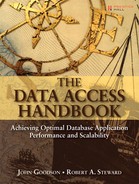Book Description
The Data Access Handbook
Achieving Optimal Database Application Performance and Scalability
John Goodson • Robert A. Steward
Drive breakthrough database application performance by optimizing middleware and connectivity
Performance and scalability are more critical than ever in today’s enterprise database applications, and traditional database tuning isn’t nearly enough to solve the performance problems you are likely to see in those applications. Nowadays, 75-95% of the time it takes to process a data request is typically spent in the database middleware. Today’s worst performance and scalability problems are generally caused by issues with networking, database drivers, the broader software/hardware environment, and inefficient coding of data requests. In The Data Access Handbook, two of the world’s leading experts on database access systematically address these issues, showing how to achieve remarkable improvements in performance of real-world database applications.
Drawing on their unsurpassed experience with every leading database system and database connectivity API, John Goodson and Rob Steward reveal the powerful ways middleware affects application performance and guide developers with designing and writing API code that will deliver superior performance in each leading environment. In addition to covering essential concepts and techniques that apply across database systems and APIs, they present many API examples for ODBC, JDBC, and ADO.NET as well as database system examples for DB2, Microsoft SQL Server, MySQL, Oracle, and Sybase.
Coverage includes
Clearly understanding how each component of database middleware can impact performance and scalability
Writing database applications to reduce network traffic, limit disk I/O, optimize application-to-driver interaction, and simplify queries—including examples for ODBC, JDBC, and ADO.NET
Managing connections, transactions, and SQL statement execution more efficiently
Making the most of connection and statement pooling
Writing good benchmarks to predict your application’s performance
Systematically resolving performance problems—including eight start-to-finish case-study examples
If you’re a software architect, system designer, or database application developer, The Data Access Handbook will be your most indispensable database application performance resource. It’s the one book that focuses on the areas where you can achieve the greatest improvements—whether you’re designing new database applications or troubleshooting existing ones.
John Goodson is vice president and general manager of the DataDirect division of Progress Software, a leader in
data connectivity and mainframe integration. For 20 years, he has worked with Sun, Microsoft, and others to develop database connectivity standards such as J2EE, JDBC, ODBC, and ADO. He served on the ANSI H2 committee that built the SQL standard and now participates in the JDBC Expert Group and Java Rowsets standards committees.
Rob Steward, vice president of R&D at the DataDirect
division of Progress Software,
is responsible for the development, strategy, and oversight of the company’s data connectivity products. Rob has spent the past 15 years developing high-performing database driver and data providers, including ODBC, JDBC, and ADO.NET.
Both authors have spoken on database application performance at many industry events.
Visit www.dataaccesshandbook.com to get the code examples presented in this book and other supplemental information for DB2, MicrosoftSQL Server, MySQL, Oracle, and Sybase.
Table of Contents
- Title Page
- Copyright Page
- Dedication
- Contents
- Preface
- Acknowledgments
- About the Authors
- CHAPTER ONE Performance Is n’t What It Used to Be
- CHAPTER TWO Designing for Performance: What’s Your Strategy?
- CHAPTER THREE Database Middleware: Why It’s Important
- CHAPTER FOUR The Environment: Tuning for Performance
- CHAPTER FIVE ODBC Applications: Writing Good Code
- CHAPTER SIX JDBC Applications: Writing Good Code
- CHAPTER SEVEN .NET Applications: Writing Good Code
- CHAPTER EIGHT Connection Pooling and Statement Pooling
- CHAPTER NINE Developing Good Benchmarks
- CHAPTER TEN Troubleshooting Performance Issues
- CHAPTER ELEVEN Data Access in Service-Oriented Architecture (SOA) Environments
- Glossary
- Index
